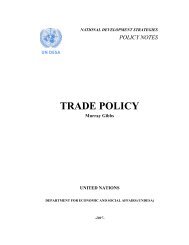16th Meeting of Senior Fellowships Officers of the ... - Development
16th Meeting of Senior Fellowships Officers of the ... - Development
16th Meeting of Senior Fellowships Officers of the ... - Development
Create successful ePaper yourself
Turn your PDF publications into a flip-book with our unique Google optimized e-Paper software.
40<br />
<strong>16th</strong> <strong>Meeting</strong> <strong>of</strong> <strong>Senior</strong> <strong>Fellowships</strong> <strong>Officers</strong> <strong>of</strong> <strong>the</strong> United Nations System and Host Country Agencies<br />
partnered with some 230 organizations in conducting training and study tours; trained<br />
some 1200 participants, serviced some 40 countries in Asia, Africa, Pacific, produced<br />
five books on various aspects <strong>of</strong> <strong>Development</strong> Management, prepared 15 guidebooks<br />
and wrote numerous articles. Most <strong>of</strong> DCAAP’s training participants had been sent by<br />
projects <strong>of</strong> partner organizations which were assisted largely by UNDP, UNFPA, WB<br />
and ADB. Those organizations also sent some <strong>of</strong> <strong>the</strong>ir own field <strong>of</strong>fice staff for training.<br />
133. Knowing that partnership was a promising strategy, DCAAP developed and continued<br />
to develop a database <strong>of</strong> over 2000 actual and potential partners composed <strong>of</strong><br />
government organizations, non-government organizations, non-pr<strong>of</strong>it organizations,<br />
academic institutions, business firms, religious organizations and international funding<br />
organizations from Asia, Africa and <strong>the</strong> Pacific. DCAAP fur<strong>the</strong>r established partnerships<br />
with some 20 national organizations in 15 Asian countries conducting in-country<br />
and inter-country study tours. Since 1995 it had coordinated 16 study tours with<br />
over 50 organizations.<br />
134. Mr. Mercado noted in his paper that DCAAP had identified three types <strong>of</strong> partnership.<br />
Firstly, a service provider-client partnership where DCAAP was <strong>the</strong> trainer for trainees<br />
sent by partner organizations. Secondly, a partnership where both partner organizations<br />
served as trainers for a number <strong>of</strong> o<strong>the</strong>r organizations. Thirdly, a client-service provider<br />
relationship where DCAAP asked a partner organization to service DCAAP’s needs.<br />
135. Projecting on <strong>the</strong> near future, DCAAP did not intend to increase its internal staffing<br />
but intended to increase <strong>the</strong> number <strong>of</strong> partners, locally and internationally. It intended<br />
to grow not so much financially as intellectually by sharing its knowledge with<br />
partner training institutions worldwide, if possible, through <strong>the</strong> continuous assistance<br />
<strong>of</strong> <strong>the</strong> United Nations system.<br />
136. Mr. Mercado’ paper drew <strong>the</strong> attention to <strong>the</strong> fact that in teaming up with o<strong>the</strong>r organizations<br />
it was important to guarantee that a potential partner was reliable and stable.<br />
The Memorandum <strong>of</strong> Agreement (MOA) with each partner institution indicated <strong>the</strong><br />
parties concerned, <strong>the</strong> statement <strong>of</strong> work, <strong>the</strong> period <strong>of</strong> <strong>the</strong> contract, <strong>the</strong> mode <strong>of</strong> payment,<br />
<strong>the</strong> termination <strong>of</strong> <strong>the</strong> contract and <strong>the</strong> signatures <strong>of</strong> <strong>the</strong> representatives <strong>of</strong> <strong>the</strong><br />
contracting parties. DCAAP also verified <strong>the</strong> legal status <strong>of</strong> <strong>the</strong> potential partner organizations<br />
before formalizing <strong>the</strong> link. In order to ensure <strong>the</strong> quality <strong>of</strong> outputs <strong>of</strong> its<br />
partner organization DCAAP attached to <strong>the</strong> MOA a copy <strong>of</strong> <strong>the</strong> Terms <strong>of</strong> Reference<br />
(TOR). The TOR included <strong>the</strong> title <strong>of</strong> activity, an introduction, objectives, expected<br />
outputs, activities, <strong>the</strong> duration and responsibilities. To ensure that <strong>the</strong> partner organizations<br />
submitted <strong>the</strong> proper evaluation data after <strong>the</strong> training took place DCAAP<br />
sent an appropriate questionnaire, instructions on how to complete it, a sample <strong>of</strong> a<br />
completed form and appropriate dummy tables. In order to guarantee that <strong>the</strong> partner<br />
organizations submitted <strong>the</strong> expected report on time, DCAAP sent contents <strong>of</strong> earlier<br />
related reports, edited <strong>the</strong> reports from each country and sent a copy to each partner<br />
for final review.

















